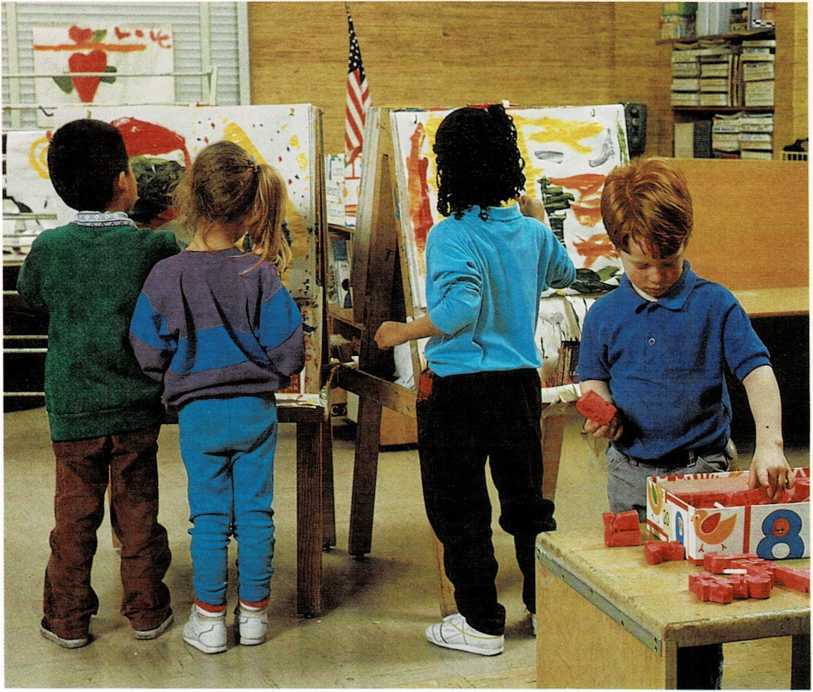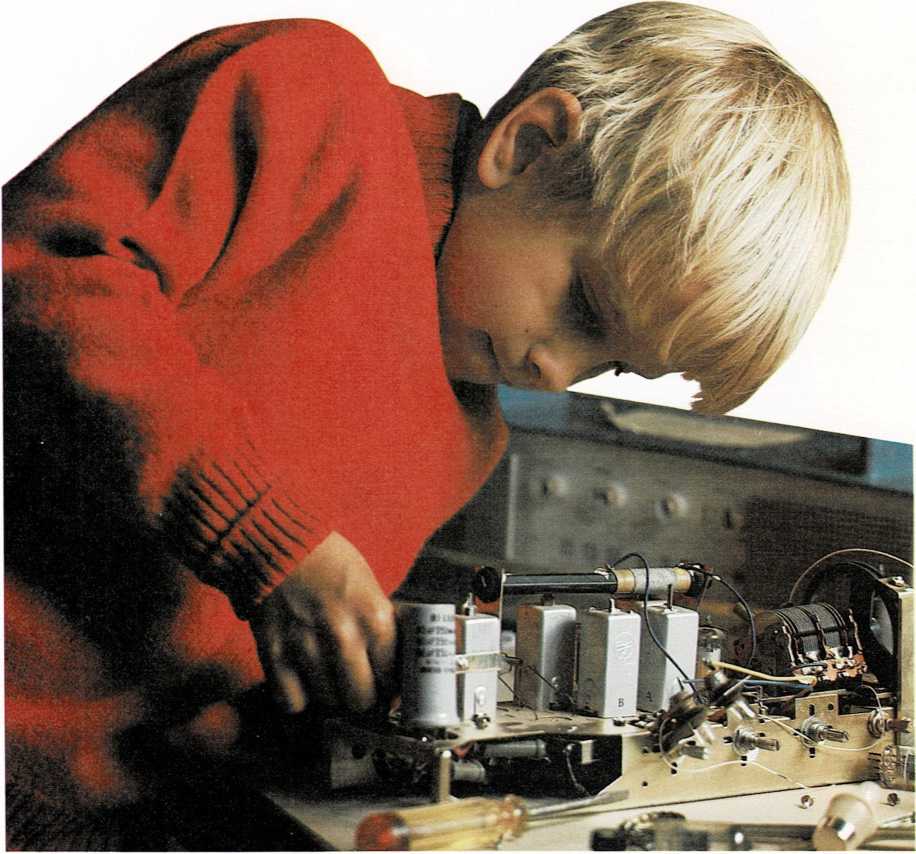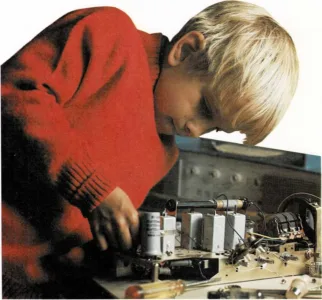Common concerns

During the early school years, children are presented with a new social
environment and social challenges unlike any they have had before. At
home they were usually in an atmosphere in which it was taken for
granted that they belonged and were accepted. This gave them a natural
security. Certainly at home, children have had to adapt to parents and
brothers and sisters. But the home atmosphere is unlike the challenge
and interaction provided by contact with 25 or 30 classmates. Because of
these new conditions, differences related to sex and age may become
apparent and certain problems may appear in the children’s lives.
Sex differences
Girls, when they start school, appear more mature than boys—and they
are, because they have a more rapid maturation rate than boys do during
these years. Physically and emotionally, girls are more apt to become
organized and ready to work with symbolic and abstract tasks sooner than
boys.
Patty can print her name correctly when she enters kindergarten, while
Peter, who is the same age, may only recognize the first letter of his
name. This does not mean that Patty is the brighter of the two. It may
mean merely that someone took the time to teach her what she knows and
that she may have been eager to learn this. Peter, on the other hand,
may already know about many other things. Having classmates who can
print their names and a teacher who can be helpful may encourage him to
learn. It may
also encourage him to share his knowledge with others.
Boys do indeed have much intellectual curiosity, but they more often
focus their curiosity on physical, biological, and mechanical areas.
They like to take things apart— like flashlights, old clocks, old
radios—to find out what the component parts are and how they work.
They discover and explore things by poking around. They are liable to
walk in the kitchen with wet feet and ask the question, “Where does the
water go after it goes down the sewer?”
This is. not to say girls do not show these interests. Many do. And many
go on to become scientists.
Age differences
No matter how bright children may be, it may make an immense difference
whether they have lived less than five years or almost six years when
they enter kindergarten. Younger children are less mature than their
classmates and less experienced. They are often—though not always—at
a disadvantage.
Suppose September 1 is the cutoff date for kindergarten entrance in a
school district. This means that a child who became 5 years old on
September 2 of the previous school year is in the same class with the
child who will be 5 on September 1 of the current year. The child
entering kindergarten at nearly six years has a decided advantage over a
classmate at five years. The older child is better coordinated, more
able to

Age differences may lead to problems in social
adjustment as well as learning problems.
control impulses, and more able to concentrate on a learning task. If
the younger child is a boy, he may find it doubly hard to compete with
his classmates.
Regardless of intellectual ability, many kindergarten children cannot
bridge the age-maturity gap between themselves and their older, more
mature classmates. They may also have difficulty conforming to the
arbitrary learning timetable of many schools. The real test comes in
first grade, when most schools require children to begin reading. As one
boy sadly commented, “I always get a stomachache before I go to school.
I go anyhow and I feel sicker because I don’t catch on. And everybody
knows I don’t catch on. It’s no fun.”
The younger kindergarten child should be closely observed for the
development of social and other school-related readiness
skills. A delay in the acquisition of these skills may be due to
immaturity, and a developmental evaluation should be considered.
Masculinity, femininity
This is the age when a problem with sex identification may become
evident in a child. The child, especially a boy, may be ridiculed by his
classmates. The child may also appear to be confused and pained among
classmates, even at the kindergarten or first-grade level.
Do not leap to the conclusion that a child has a problem in sex
identification because of a few surface traits or activities—merely
because a girl is skilled in athletics, for example, or because a boy
helps his mother dust furniture. However, if a girl deeply resents being
a girl or if a boy deeply resents being a boy, a problem may exist.

School-age children enjoy all kinds of boisterous, bustling
activities.
If a problem in sex identification is handled during these
kindergarten-primary years, chances of improvement are far greater than
if parents wait. When the child’s problem is viewed as something that
will be “outgrown,” difficulties multiply and eventually the child
becomes enmeshed in the web of added preadolescent and adolescent
problems. The original problem is then
submerged, and the child’s life may become increasingly bewildering and
lonely. If parents believe that their child has a problem in sex
identification, they should seek professional help from a psychologist
or child psychiatrist. The child’s doctor or teacher may be able to
provide the names of agencies and specialists who can help the child and
parents.

Some boys meet with academic failure in the primary grades because
they are more interested in such things as dismantling a radio or
taking apart a flashlight.
School problems
School is such an important part of a child’s life that all youngsters
face some problems in the many years that they spend there. Therefore,
parents and teachers must stay in close communication.
Problems that have their origin in school may show up only at home. For
example, a youngster who operates under tension all day long at school
may seem like an earnest, conscientious child to the teacher. The
parents may be the only ones to see the outbursts that reflect the
strain the child is feeling. Similarly, a youngster may appear at home
to be working smoothly. The teacher, watching the child in a different
setting and in comparison with other children the same age, may be the
one who first becomes aware that a problem exists. The parents and the
teacher must have some means of sharing their insights, so that any
problems can be spotted before they become too severe, and solutions can
be developed.
Unwillingness to go to school
The first sign of a school problem may be a child’s unwillingness to go
to school. Some kindergarten and first-grade children show their fear of
school openly. They cry, say that they hate school, and are unwilling to
leave home. Sometimes unwillingness to go to school shows in disguised
form through frequent complaints of illness or through prolonged
dawdling and other delaying tactics. A fear or dislike of school can be
a troubling problem. All the “legal” arguments parents are apt to use
carry little weight in a young child’s mind.
There are, of course, no pat solutions to this or any other problem. The
causes can be many, and they vary from child to child. The only good
solution is the one that gets to the root of the difficulty with
individual children. Some youngsters may hesitate because they have not
had sufficient experience in being away from home; others because the
group at school is too large for them to cope with; others because they
have specific fears, such as the school toilet or the bus ride. This
unwillingness can also be a sign that a child is experiencing learning
difficulties.
When parents and teachers begin to talk together and pool their
information, they usually can uncover the difficulties and make plans
that help children identify the problems, cope with them, and possibly
solve them. The parents’ attitudes are important while this search is
going on. On the one hand, they must feel sympathetic to children who
have problems. Life can be uncomfortable when something is going wrong.
On the other hand, parents must have a broad, basic confidence that
problems can be solved, and must communicate it. The steady sureness
that solutions will be found and that life can go on is often one of the
most helpful ways of building self-confidence and security in children.
Problems related to success ■ and failure
As children move further into their school careers, more difficulties
are apt to stem from their successes and failures in academic work, and
from relationships with classmates and teacher. Children are like the
rest of us. They cannot go through day after day of failure, of not
liking their assigned tasks, and of not enjoying people with whom they
associate, without feeling some dissatisfaction. Adults change their
jobs when they feel this way. Children cannot leave school physically.
Their only alternative is to leave mentally—to daydream, to give up in
despair, to become rebellious.
Again, there is no single answer to every child’s trouble. A patient,
mutual search by parents and teacher is the only wise procedure. A
physical difficulty, with vision or hearing in particular, may be the
cause in some cases. Academic work puts the first great strain on
hearing and vision. A complete physical examination is often a wise
first step in seeking solutions.
Children, of course, vary greatly in their ability to do schoolwork.
They vary in their native intelligence, in their growth rate, and in
their ability to handle specific kinds of subject matter. There is
always the possibility that, without meaning to, either parents at home
or teachers at school may be asking more of the children than they are
able to do. When goals and expectations are set too high, children
almost always do not succeed
as well as they could. The school administration’s solution is sometimes
to readjust its program, aiming more realistically at goals that
youngsters can achieve. Sometimes parents must make the adjustment in
their expectations at home so that their children feel that they are
good human beings and not constant failures.
Some youngsters face a problem because they are “underachievers.” They
have considerably more ability than they use. They glide through their
days, operating on only a small part of their ability. On the face of
it, this may seem not like a problem but a joy. However, youngsters are
much more contented when they work up to their ability. Unchallenged,
these children can move quite easily into various forms of misbehavior
that reflect their discontent.
It is easier to overlook children who are underachieving than the child
who daily meets failure. Failing children quickly call themselves to
adult attention. Underachievers can slide by unnoticed. Parents and
teachers need not search for problems that do not exist, but it is
important for both to talk together so that real problems are not
ignored. A parent’s account, for example, of a child’s unusual
persistence and success with a hobby or an out-of-school activity may be
the tipoff to a teacher that the youngster has more ability than the
school has tapped.
Family problems and school
The demands of schoolwork sometimes uncover tension youngsters are
feeling in their out-of-school lives. Children who worry about their
place in the family, or about their relations with their brothers and
sisters, cannot concentrate and meet the rigors of academic work. These
difficulties may well have gone unnoticed during the children’s simpler,
less demanding years before school. Many school systems have
psychologists who are trained to spot and treat such problems. Many
communities have child guidance centers or family service societies that
can help with these problems.
Social problems
School, of course, is not all academic work. A school is a social
center, too. Conflicts and achievements in getting along with classmates
take place daily. A child’s social acceptance or rejection is important
in itself and often has repercussions on how well the child learns. The
lonely child frequently adds academic difficulties to other miseries.
Problems in a child’s social life are perhaps the hardest of all for
adults to solve. Adults cannot force one child to like another. But they
can sometimes help a child to be more likable. Teaching the isolated
child some skills that other youngsters value is one useful approach.
Inviting classmates home after school is another way. Teachers can use
seating arrangements or school activities to help bring together
children who may learn to like each other.
Solutions to school problems
Parents and teachers both must realize that it takes time, patience, and
wisdom to solve all human problems. It is so easy to believe that there
are quick solutions—the teacher should assign more work in school; the
parents should take away privileges until a child’s work improves. In
individual instances these may be useful approaches, but they are not
cures in every case. In some instances, a final cure may take a long
time to achieve. Some of the factors that can be involved—for example,
large class size, a teacher’s long-established way of teaching, or a
home’s way of treating a child—do not lend themselves to modification
overnight.
Parents and teachers both must feel good will and be patient in working
together if answers are to be found. No one wants a child to face a
problem needlessly. Everyone wants the best for a child. But school and
family life both center around humans, and humans change slowly. It is
important to recognize, too, that there are some problems children have
to solve themselves. There are other problems that have no solutions,
but children can be taught to live with them and even gain strength from
the experience.

